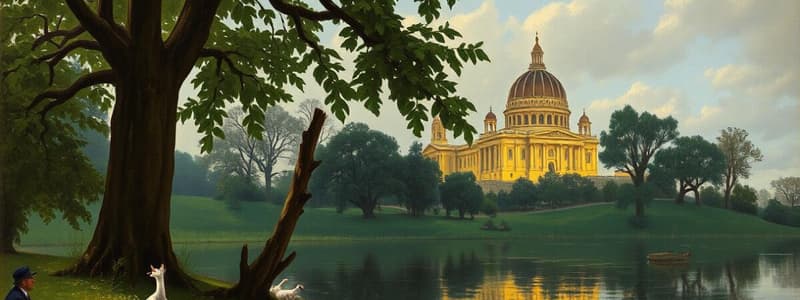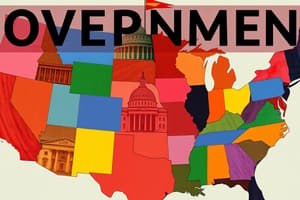Podcast
Questions and Answers
What is limited government?
What is limited government?
- A government that can take away individual rights.
- A government with absolute power.
- The idea that government is not all-powerful. (correct)
- A government that has control over all aspects of life.
What does representative government represent?
What does representative government represent?
- Only the wealthy citizens.
- The monarchy's decisions.
- A single-party system.
- The will of the people. (correct)
What is the Magna Carta?
What is the Magna Carta?
Great Charter forced upon King John of England in 1215, establishing that the monarchy's power is not absolute.
What was the Petition of Rights?
What was the Petition of Rights?
What is the English Bill of Rights?
What is the English Bill of Rights?
What does due process ensure?
What does due process ensure?
What is a charter?
What is a charter?
What does bicameral mean?
What does bicameral mean?
What defines a royal colony?
What defines a royal colony?
Name the three kinds of colonies.
Name the three kinds of colonies.
What were the Congressional Powers under the Articles of Confederation?
What were the Congressional Powers under the Articles of Confederation?
What obligations did States have to one another under the Articles of Confederation?
What obligations did States have to one another under the Articles of Confederation?
What were the obligations of states to citizens?
What were the obligations of states to citizens?
What powers did Congress not have under the Articles of Confederation?
What powers did Congress not have under the Articles of Confederation?
What was the goal of the Constitutional Convention?
What was the goal of the Constitutional Convention?
What is ratification?
What is ratification?
Who were the Framers?
Who were the Framers?
What is federalism?
What is federalism?
Who were the leaders of the Federalists?
Who were the leaders of the Federalists?
What did Anti-Federalists believe?
What did Anti-Federalists believe?
What did Anti-Federalists want to add to the Constitution?
What did Anti-Federalists want to add to the Constitution?
How many states were needed to ratify the Constitution for it to go into effect?
How many states were needed to ratify the Constitution for it to go into effect?
Which was the first state to ratify the Constitution?
Which was the first state to ratify the Constitution?
Which state was the last to ratify the Constitution?
Which state was the last to ratify the Constitution?
What was the first capital of the United States under the Constitution?
What was the first capital of the United States under the Constitution?
Who was elected the first president of the United States?
Who was elected the first president of the United States?
What were the arguments of the Federalists?
What were the arguments of the Federalists?
What were the arguments of the Anti-Federalists?
What were the arguments of the Anti-Federalists?
Flashcards are hidden until you start studying
Study Notes
Key Concepts in American Government Origins
- Limited Government: Establishes that government has restricted powers; individual rights cannot be infringed upon.
- Representative Government: Emphasizes that government should reflect the will of the people, allowing their voice in governance.
Historical Documents Influencing American Government
- Magna Carta (1215): Limited monarchical power and guaranteed rights such as trial by jury.
- Petition of Rights (1628): Asserted that the monarchy is subject to law, challenging the divine right of kings.
- English Bill of Rights (1689): Aimed to prevent monarchs from abusing their powers, establishing important civil liberties.
Types of Colonies
- Royal Colony: Directly controlled by the king; government authority lies with royal appointments.
- Proprietary Colony: Managed by individuals authorized by the king, who hold land grants.
- Charter Colony: Established by documents from the king; included Massachusetts (initially), Rhode Island, and Connecticut.
Legislative Structures
- Bicameral: Legislative body with two chambers (e.g., U.S. Congress).
- Unicameral: Legislative body with one chamber.
Colonial Relations and Governance
- Committees of Correspondence: Networks set up to organize resistance against British rule.
- First Continental Congress: Gathered representatives from most colonies in Philadelphia to unify against British policies.
- Intolerable Acts: Series of punitive laws imposed by Britain that escalated colonial discontent.
Tensions Leading to Independence
- Boycott: Colonists’ refusal to purchase British goods as a form of protest.
- Shays' Rebellion: A revolt highlighting weaknesses in the Articles of Confederation, prompting calls for a stronger central government.
Constitutional Convention and Compromises
- Goal: To revise the Articles of Confederation, aiming to create a more effective governmental structure.
- Virginia Plan: Proposed representation based on population, favoring larger states.
- New Jersey Plan: Suggested equal representation for states, preserving the Articles’ framework.
- Connecticut Compromise: Established a bicameral legislature with aspects from both plans to balance representation.
Fundamental Principles
- Popular Sovereignty: Indicates that the authority of government rests with the people.
- Separation of Powers: Distributes government powers into legislative, executive, and judicial branches to prevent abuse.
Rights and Liberties
- Unalienable Rights: Basic rights inherent to individuals that cannot be surrendered.
- Bill of Rights: Advocated for by Anti-Federalists, aimed to secure essential liberties against government infringement.
Federalist vs. Anti-Federalist Perspectives
- Federalists: Supported the Constitution, advocating for a strong federal government as essential for stability and governance.
- Anti-Federalists: Opposed ratification, fearing centralized power might lead to tyranny; highlighted the lack of a Bill of Rights as a crucial concern.
Ratification Process
- Required States: Nine states needed to ratify the Constitution for it to take effect.
- Delaware: First state to ratify; New Hampshire was the ninth, bringing the Constitution into effect.
Initial Leadership
- First President and Vice President: George Washington was elected first president, followed by John Adams as vice president, marking the establishment of executive leadership under the new Constitution.
Studying That Suits You
Use AI to generate personalized quizzes and flashcards to suit your learning preferences.




